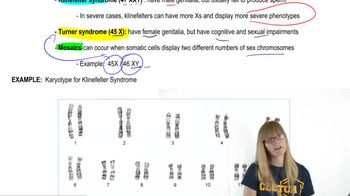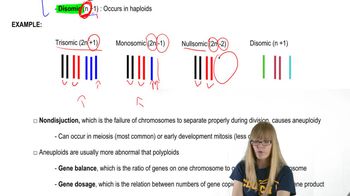Here are the essential concepts you must grasp in order to answer the question correctly.
Karyotype
A karyotype is a visual representation of an individual's chromosomes, organized in pairs and arranged by size. It is used to identify chromosomal abnormalities, such as aneuploidy, which is an abnormal number of chromosomes. In humans, a normal karyotype consists of 46 chromosomes, arranged into 23 pairs.
Recommended video:
Aneuploidy
Aneuploidy refers to the presence of an abnormal number of chromosomes in a cell. This can occur due to nondisjunction during meiosis, leading to gametes with an incorrect number of chromosomes. In the case of Down syndrome, which is caused by trisomy 21, there is an extra copy of chromosome 21, resulting in a total of 47 chromosomes in affected individuals.
Recommended video:
Inheritance Patterns
Inheritance patterns describe how genetic traits and conditions are passed from parents to offspring. In the context of Down syndrome, it is important to understand that while the boy has 47 chromosomes, his parents and sisters, having 45 chromosomes, suggest a possible chromosomal abnormality in the parents. This could indicate a structural rearrangement or a condition like Turner syndrome, which affects the number of sex chromosomes.
Recommended video:
 Verified step by step guidance
Verified step by step guidance Verified video answer for a similar problem:
Verified video answer for a similar problem:



 12:42m
12:42m